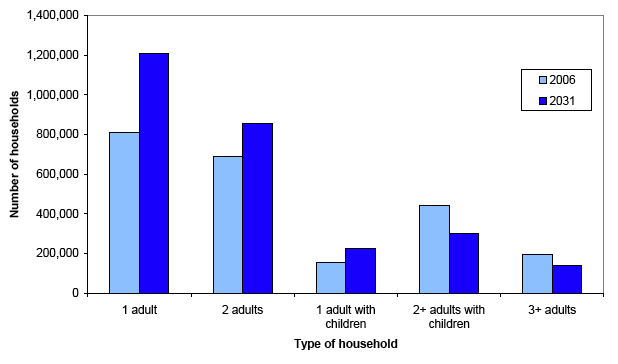
3.1 Overall number of households (Table 1)
The number of households in Scotland is projected to increase from under 2.3 million to over 2.7 million between 2006 and 2031 - an increase of 19 per cent. Over the same period, the projected increase in Scotland’s population is around 5 per cent. Most of the 19 per cent increase in the number of households is due, therefore, to more people living alone or in smaller households. The average household size is projected to decrease from 2.19 in 2006 to 1.93 in 2031. This reflects a continuation of the long-running decline in average household size – in 1971, the average household size was around three people.
The projected yearly increase in the number of households is 17,600. It is higher in the earlier part of the projection period than the later years. In the first 10 years of the projection period, the average annual increase is nearly 21,000 households, compared with 15,400 in the final 15 years of the projection period. The average annual increase declines over time since the average annual increase in population also tends to decrease over the projection period. This is a result of the changes in the underlying assumptions on the number of births and deaths and the level of net migration.
3.2 Type of household (Table 1)
Figure 1 shows the projected number of households of each type, in 2006 and 2031. There is a large increase in the number of adults living alone, from 809,000 (35 per cent of all households) in 2006 to over 1.2 million (44 per cent) by 2031. Households containing just two adults without children are projected to rise from 687,000 to 858,000, and the number of households containing one adult with children is projected to rise from 157,000 to 226,000. In contrast, the number of larger households is projected to fall, with households containing two or more adults with children decreasing from 443,000 (19 per cent of all households) in 2006 to 300,000 (11 per cent) by 2031. There is also a projected decrease in the number of households containing three or more adults, from 195,000 to 139,000.
Figure 1: Projected number of households in Scotland by household type, 2006 and 2031

3.3 Age of head of household (Table 2)
Figure 2 shows the projected number of households in 2006 and 2031, by the age of the head of household (the ‘head’ of household is normally the first person entered on the Census form). The population projections show that Scotland’s population is ageing, with a projected increase in the number of people in the older age groups, and fewer people in the younger age groups. This trend is reflected in the household projections, with the largest increases shown in households headed by people aged 60 and over (an increase of over 50 per cent between 2006 and 2031, from 753,000 to 1.14 million). In contrast, households headed by someone aged under 60 are projected to increase by just four per cent, to around 1.59 million. The number of households headed by someone aged 85 or over is projected to more than double over the same period, from 69,000 to 177,000.
Figure 2: Projected number of households in Scotland by age of head of household, 2006 and 2031
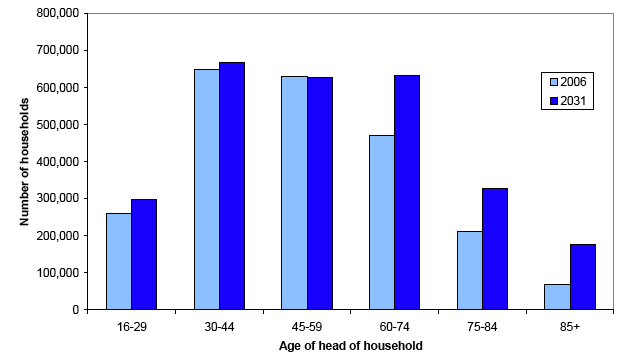
3.4 Household type by age of head of household (Tables 3 and 4)
One adult households: In 2006, 19 per cent of the population aged 16 or over lived alone, and this is projected to rise to 27 per cent by 2031. The figures in Table 4 show that people are more likely to live alone as they become older, with 62 per cent of people aged over 85 projected to be living alone in 2031. The figures vary according to gender and age, as illustrated in Figures 3a and 3b. In 2006, in most age groups up to their mid-50s, men are more likely to live alone than women. From the age of 55 onwards, however, women are more likely to live alone, and the figures increase with age. This is influenced by women’s greater life expectancy, and the tendency of women to marry men who are older than them. In 2031, 79 per cent of women aged over 85 are projected to live alone compared to 38 per cent of men in the same age group.
The gap between the average life expectancy of men and women in Scotland is decreasing. This means that the number of older men is projected to increase more rapidly than the number of older women, which contributes to the projected increase in the number of men living alone, from 353,000 households in 2006 to 554,000 in 2031, an increase of over a half. The number of men living alone who are aged 85 or over is projected to increase from 11,000 to 35,000.
Figure 3a: Percentage of people living alone in 2006, by age and gender
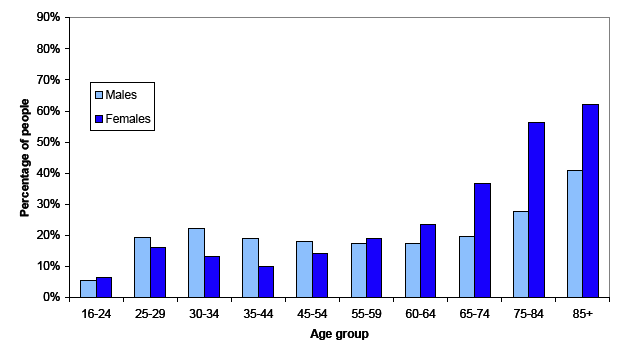
Figure 3b: Projected percentage of people living alone in 2031, by age and gender
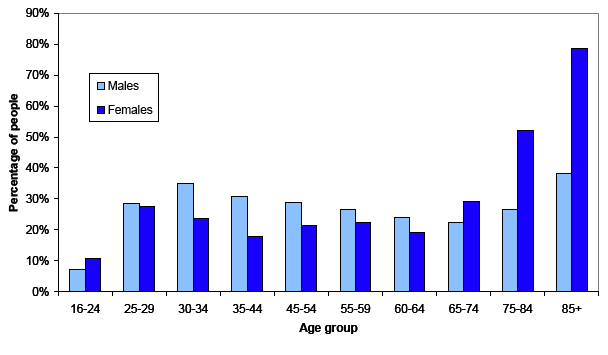
Households containing two or more adults without children: There are large projected increases in the number of households containing two adults without children in the older age groups, which is likely to be influenced by the increase in average life expectancy and the narrowing of the gap between the life expectancy of men and women. The number of two or more adult households headed by someone aged 60 or over is projected to increase by 46 per cent, from 370,000 in 2006 to 540,000 in 2031. In contrast, Figure 4 illustrates that the number of households with three or more adults is declining over the projection period in all age groups except for those aged 16-29. Households with three or more adults in this age group are projected to almost double from 23,000 in 2006 to 44,000 in 2031.
Figure 4: Projected number of households in Scotland by household type and age of the head of household: 2006 and 2031
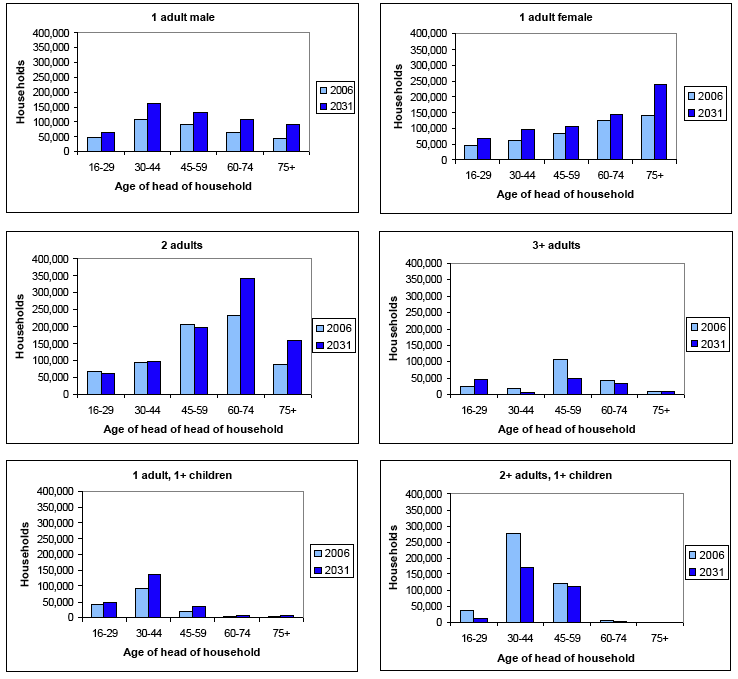
Households containing one adult with children: In 2006, seven per cent of all households consisted of one adult living with one or more children, and this is projected to increase to eight per cent in 2031. There are projected increases in the number of households of this type for all age groups, particularly those aged 45 and over.
Households containing two or more adults with children: In 2006, 19 per cent of households contained two or more adults with children; this figure is projected to fall to 11 per cent by 2031. There are reductions in all age groups, with the biggest reductions occurring in the younger age groups, which may reflect an increase in the average age at which women have their first child.
3.5 Household projections by household type and local authority area (Tables 5-17)
Household projections by household type and age group for all 32 local authority areas can be found in the Household Projections section of the GROS website.
It should be noted that projections for areas with small populations tend to be less reliable than those for areas with larger populations.
Total number of households by local authority area (Table 5): The number of households in almost every local authority area is projected to increase. Figure 5a shows the projected number of households in each local authority area in 2006 and 2031.
Figure 5b shows the projected percentage change in the number of households between 2006 and 2031 and Map 1 also shows this information. The largest projected increases between 2006 and 2031 are in Orkney Islands, West Lothian and Edinburgh (35 per cent). Perth and Kinross, Aberdeenshire and East Lothian also have projected increases of over 30 per cent. In contrast, Inverclyde has a projected decrease of three per cent over the same period, and East Dunbartonshire has a projected decrease of two per cent.
One adult households (Tables 6 and 7): Map 2 shows the projected percentage of households which contain just one adult, in each local authority area, in 2031. In general, the city authorities are projected to have some of the highest proportions of people living alone, comprising between 46 and 54 per cent of all households in Aberdeen, Dundee, Edinburgh and Glasgow in 2031, compared to a Scottish average of 44 per cent. In every local authority area there is a projected increase in the number of people living alone between 2006 and 2031 and the highest projected increase occurs in West Lothian (84 per cent).
Households containing one adult with children (Tables 6 and 8): Almost all local authority areas are projected to see an increase in the number of households consisting of one adult with one or more children, except for Moray which shows a decrease of 15 per cent between 2006 and 2031. The highest increase occurs in East Lothian where the number of households of this type is projected to nearly double to 4,800 households in 2031 compared to the average increase in Scotland of 44 per cent. Glasgow City is projected to have the highest proportion of households of this type in 2031 (11 per cent). The smallest proportions are in Moray and Orkney Islands (2-3 per cent of all households in these areas).
Households containing two or more adults without children (Tables 6 and 9): The proportion of households consisting of two or more adults but no children in 2031 is projected to vary from 26 per cent in Glasgow City to 45 per cent in Moray with an average Scotland figure of 36 per cent.
Figure 5a: Projected number of households, by local authority area, 2006 and 2031
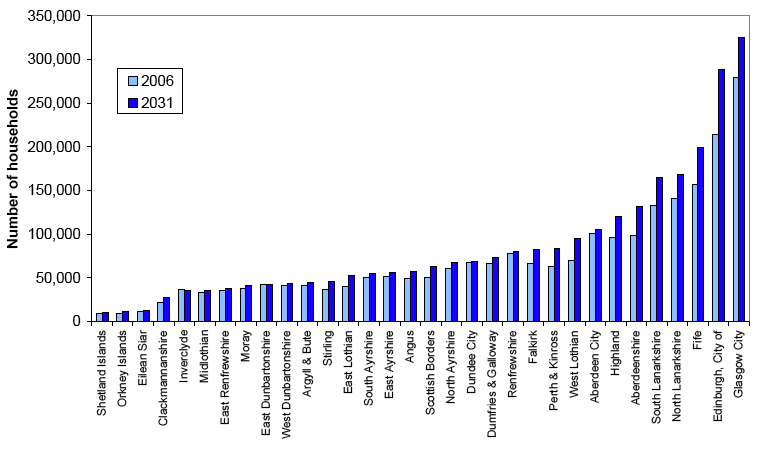
Figure 5b: Projected percentage change in the number of households, by local authority area, 2006 to 2031
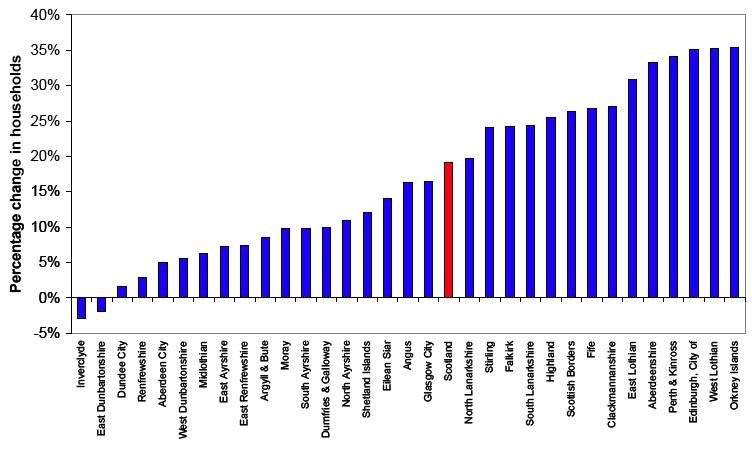
Households containing two or more adults with children (Tables 6 and 10): The number of households containing two or more adults with children is projected to decrease in every local authority area, between 2006 and 2031. The four city authorities, with some of the highest proportions of single people also have some of the smallest proportions of households comprising two or more adults with children – between 7 and 11 per cent in 2031. Eilean Siar and Shetland Islands are also projected to have a small proportion of these larger households – 8 and 9 per cent in 2031, compared to 20 and 21 per cent in 2006. The highest percentage of households of this type is projected to be in East Renfrewshire and East Lothian (18 and 15 per cent of all households respectively), though even these areas show a projected decrease between 2006 and 2031. Map 3 shows the projected percentage of households containing children (whether there are one, two or more adults), in each local authority area in 2031.
3.6 Household projections by age of the head of household and local authority area (Tables 11-16)
Every local authority area in Scotland is projected to see an increase in the number of households headed by someone aged 60-74. The largest projected increases are in Aberdeenshire (64 per cent), West Lothian (60 per cent) and Orkney Islands (52 per cent). In most local authority areas, even larger increases are projected in the number of households headed by someone aged 75 or over – the figures are projected to more than double in Aberdeenshire, Clackmannanshire, Highland, Moray, Orkney Islands, Shetland Islands and West Lothian. In contrast, the city authorities are projected to have some of the smallest increases in this age group. Map 4 shows the projected percentage of households headed by someone aged 60 and over in 2031.
3.7 Projected average household size by local authority area (Table 17)
The average household size is projected to decrease in every local authority area in Scotland. The areas with the largest projected average household size in 2031 are East Renfrewshire (2.31) and East Dunbartonshire ( 2.11). The areas with the smallest average household size in 2031 are the four main cities of Aberdeen, Dundee, Glasgow and Edinburgh, and the three island authorities of Eilean Siar, Orkney Islands and Shetland Islands (between 1.71 and 1.86). The average household size is projected to be under two people in almost three quarters of the local authority areas in 2031.